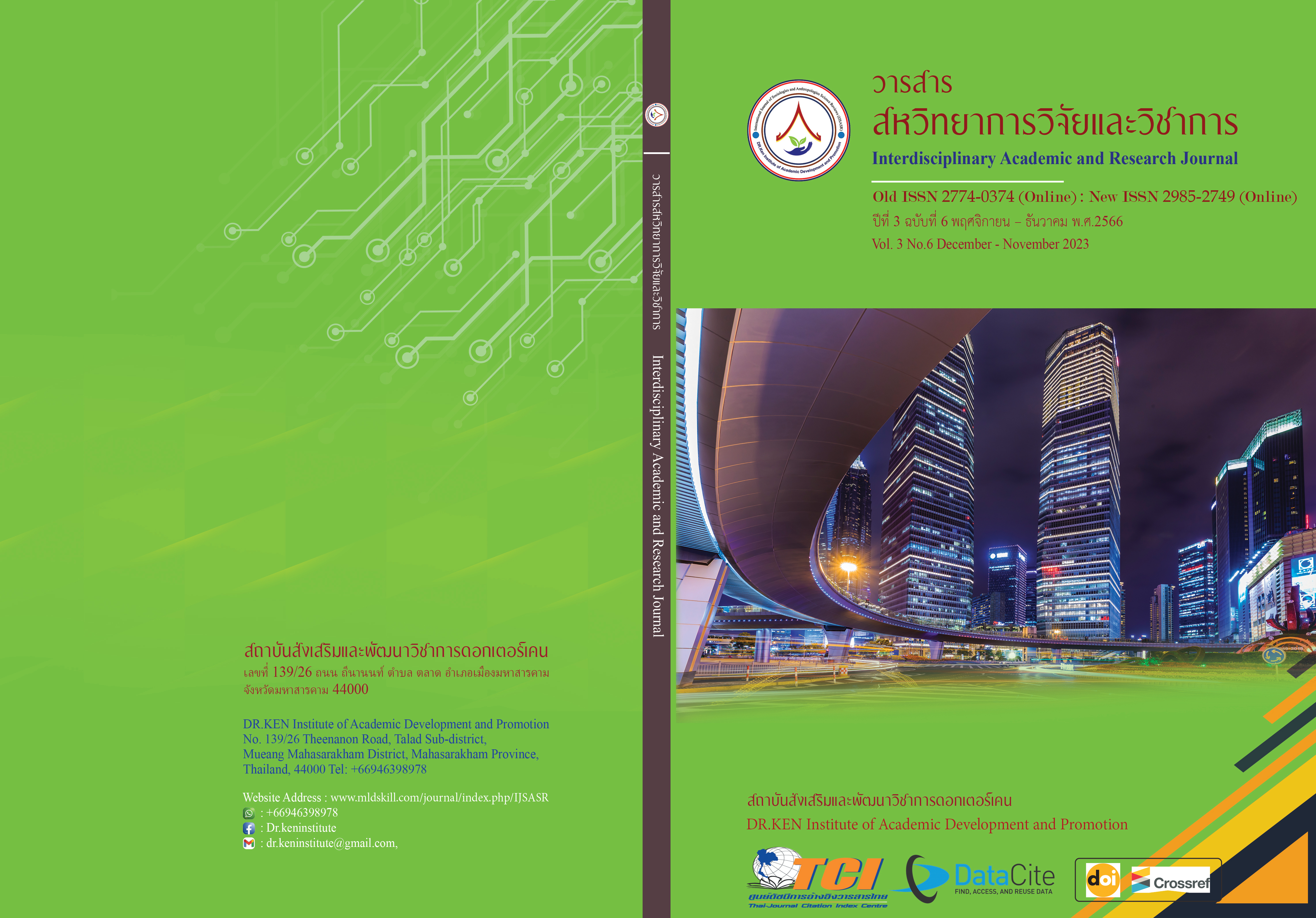The Correlation Between the Results of School Assessment and National Assessment of Prathom Sueksa One Students at Ramkhamhaeng University Demonstration School (Bangna Campus)
DOI:
https://doi.org/10.60027/iarj.2023.272153Keywords:
Relationship Studies; , Academic Achievement; , Reading Ability Assessment ResultsAbstract
Background and Aims: This research studies the relationship between the educational institution's assessment results and the national assessment results in reading Thai language learning group which is a guideline for developing learning management Promoting the quality of students' Measurement and evaluation according to standards consistent with national assessments. The objectives of the research are as follows: (1) to study the academic achievement of the Thai language learning group in reading, (2) to study the results of the reading ability assessment (Reading Test: RT), and (3) to study the relationship between academic achievement in Thai language learning subjects on reading and the results of the reading ability assessment (Reading Test: RT) of students in Prathom 1 at Ramkhamhaeng University Demonstration School, Bangna Campus.
Methodology: The sample group used in the research were students in Prathom 1 at Ramkhamhaeng University Demonstration School, Bangna Campus, in the academic year 2020, number 80 people, academic year 2021, number 73 people, and academic year 2022, number 80 people, using a simple sampling method, and statistical analysis using the descriptive statistics and Pearson correlation coefficient method.
Results: (1) Academic achievement in the Thai language learning group, reading, the academic year 2020 - 2022, evaluation results are at an excellent level, with a mean equal to 84.336, 85.159, and 81.762, respectively, and a standard deviation equal to 7.947, 7.433, and 10.051 respectively. (2) The reading ability assessment (Reading Test: RT) for the academic year 2020 - 2022. The assessment results were at a very good level, with a mean equal to 84.960, 88.727, and 87.792, respectively, and a standard deviation equal to 11.710, 11.565, and 15.244 respectively. And (3) Correlation coefficient between academic achievement in Thai language learning subjects with the results of the reading ability assessment (Reading Test: RT) in the academic year 2020 - 2022, there is a high correlation positive with statistical significance at the .01 level, sorted from highest to lowest the correlation coefficients (r) were 0.727, 0.726, and 0.713 respectively.
Conclusion: The research findings indicate excellent performance in Thai language learning, specifically in reading, during the academic years 2563-2565. The statistical correlation at the .01 level highlights a significant positive relationship between proficiency in Thai language learning and reading abilities, emphasizing the importance of learning in these domains.
References
กระทรวงศึกษาธิการ, สำนักงานคณะกรรมการการศึกษาขั้นพื้นฐาน. (2557). แนวปฏิบัติการวัดและประเมิน ผลการเรียนรู้ตามหลักสูตรแกนกลางการศึกษาขั้นพื้นฐาน พุทธศักราช 2551. พิมพ์ครั้งที่ 4. กระทรวงศึกษาธิการ: สำนักงานคณะกรรมการการศึกษาขั้นพื้นฐาน.
กระทรวงศึกษาธิการ, สำนักงานเลขาธิการสภาการศึกษา. (2560). แผนการศึกษาแห่งชาติ พ.ศ.2560-2579. กระทรวงศึกษาธิการ: สำนักงานเลขาธิการสภาการศึกษา.
จิตรา นาปาเลน และธนลาวัณย์ เพียรค้า. (2558). รายงานการวิจัยเรื่อง ความสัมพันธ์ระหว่างเกรดเฉลี่ยสะสม (GPAX) กับคะแนน O-NET ของนักเรียนชั้นมัธยมศึกษาปีที่ 3 โรงเรียนสาธิตมหาวิทยาลัยศรีนครินทรวิโรฒ (ฝ่ายมัธยม). กรุงเทพฯ: มหาวิทยาลัยศรีนครินทรวิโรฒ.
จุฑาภรณ์ มาสันเทียะ. (2563). การประเมินผลการเรียนวิชาภาษาไทย. กรุงเทพฯ: สำนักพิมพ์มหาวิทยาลัยรามคำแหง.
นพคุณ คุณาชีวะ และ สิริรัตน์ หิตะโกวิท. (2565). ความสัมพันธ์ระหว่างผลการประเมินระดับสถานศึกษากับผลการประเมินระดับชาติ ของนักเรียนระดับชั้นประถมศึกษาปีที่ 6 โรงเรียนสาธิตมหาวิทยาลัยรามคำแหง (ฝ่ายประถม). วารสารรามคำแหง ฉบับบัณฑิตวิทยาลัย, 5(1), 99-111.
พระราชบัญญัติการศึกษาแห่งชาติพุทธศักราช 2542 แก้ไขเพิ่มเติม (ฉบับที่ 2) พุทธศักราช 2545 และ (ฉบับที่ 3) พุทธศักราช 2553. (ม.ป.ป.). Retrieved from: https://person.mwit.ac.th/01-Statutes/National_Education.pdf
โรงเรียนสาธิตมหาวิทยาลัยรามคำแหง วิทยาเขตบางนา. (2562). หลักสูตรสถานศึกษาโรงเรียนสาธิตมหาวิทยาลัยรามคำแหง วิทยาเขตบางนา ปีการศึกษา 2562 (ฉบับทดลองใช้) ชั้นประถมศึกษาปีที่ 1. กรุงเทพฯ: โรงเรียนสาธิตมหาวิทยาลัยรามคำแหง วิทยาเขตบางนา.
สำนักงานคณะกรรมการการศึกษาขั้นพื้นฐาน, สำนักทดสอบทางการศึกษา. (2563). คู่มือการจัดสอบการประเมินความสามารถด้านการอ่านของผู้เรียน (RT) ชั้นประถมศึกษาปีที่ 1 ปีการศึกษา 2563. กรุงเทพฯ: สำนักทดสอบทางการศึกษา, สำนักงานคณะกรรมการการศึกษาขั้นพื้นฐาน. https://drive.google.com/file/d/13MhHGTFFqEf0THBKf2opTia7tc-_5VRe/view?fbclid=IwAR0rIGK0Z9_0vHlLIqAvbNIy_IpA4M97I0l49P4.b
ศิริชัย กาญจนวาสี. (2552). ทฤษฎีการทดสอบดั้งเดิม. พิมพ์ครั้งที่ 6. คณะครุศาสตร์ จุฬาลงกรณ์มหาวิทยาลัย.
Gafoor, K.A. (2013). Types and phases of evaluation in educational practice. Introduction to Educational Measurement and Evaluation. DOI:10.13140/2.1.3801.1680
Bloom, B.S. (Ed.). (1956). Taxonomy of educational objectives: Handbook 1. The cognitive domain. Longman.
Cohen, J. (1988). Statistical power analysis for the behavioral sciences. 2nd edition. Routledge.
Ebel, R.L., & Frisbie, D.A. (1986). Essentials of educational measurement. 4th edition. Prentice-Hall.
Kerlinger, F.N. (1986). Foundations of behavioral research. 3rd edition. Holt, Rinehart, and Winston.
Krejcie, R.V., & Morgan, D.W. (1970). Determining sample size for research activities. Educational and Psychological Measurement, 30(3), 607-610.
Sax, G. (1989). Principles of educational and psychological measurement and evaluation. 3rd Edition. Wadsworth Publishing.
Siedlecki, J. (2012). Education assessment of learning versus assessment for learning. Retrieved from: https://www.pearsonassessments.com/professional-assessments/blog-webinars/blog/2017/12/assessment-for-learning-vs--assessment-of-learning.html
Downloads
Published
How to Cite
Issue
Section
License
Copyright (c) 2023 Sirirat Hitakowit, Monchaya Sakkamart

This work is licensed under a Creative Commons Attribution-NonCommercial-NoDerivatives 4.0 International License.
Copyright on any article in the Interdisciplinary Academic and Research Journal is retained by the author(s) under the under the Creative Commons Attribution-NonCommercial-NoDerivatives 4.0 International License. Permission to use text, content, images, etc. of publication. Any user to read, download, copy, distribute, print, search, or link to the full texts of articles, crawl them for indexing, pass them as data to software, or use them for any other lawful purpose. But do not use it for commercial use or with the intent to benefit any business.
















.png)


